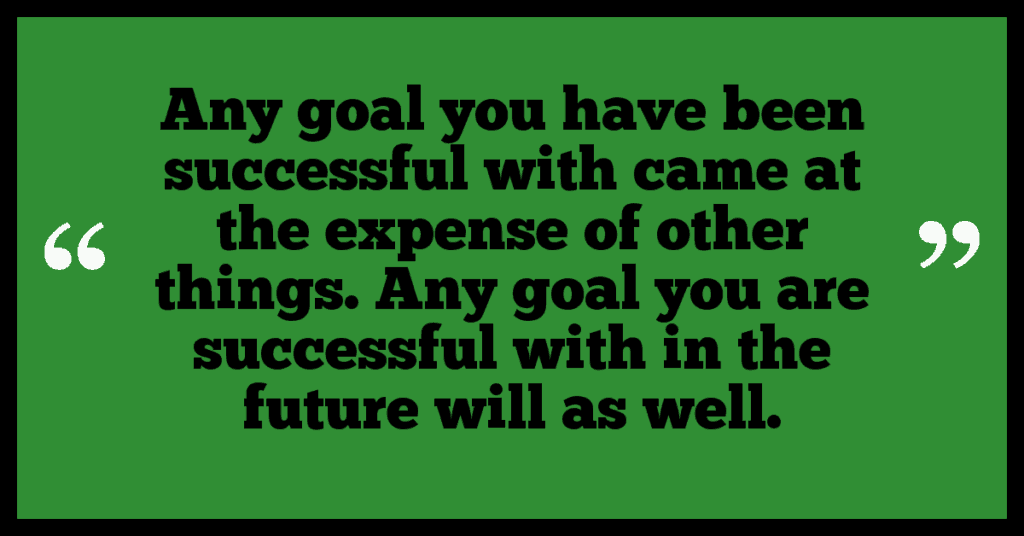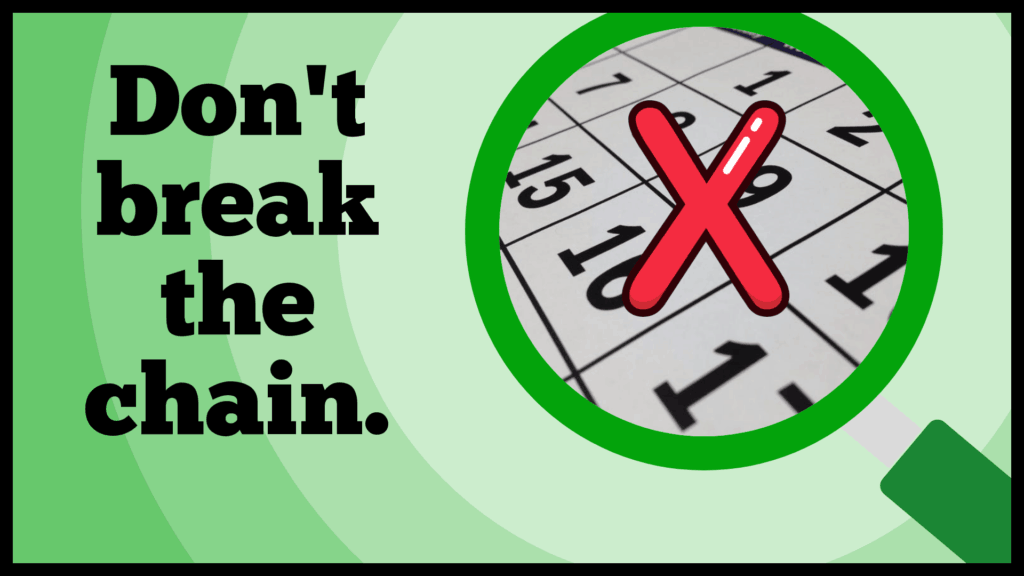Have you ever noticed how easy it is to set a goal but then not follow through and achieve it?
What if I told you that there were a few small changes you could make to your own goal setting that would make it much, much more likely that you actually accomplish yours?
Normally what happens
In my experience, this has to do with how we’ve been taught (or not taught) to think about and approach goal-setting.
If you are tired of setting goals that don’t get accomplished, keep reading to learn how you can greatly increase your odds of success with all your future goals.
Why You Don’t Accomplish More Goals

While
In other words, you might be dooming yourself to failure before you even get started.
Here are some of the ways you may be doing a poor job at setting your goals:
- Setting too many goals
- Not connecting your goals with specific actions you must take now
- Not identifying what you have to give up to make success possible
- Not making progress measurable
Now let’s go through these in more detail
There’s a good chance you have too many goals.

You probably think that your list isn’t that big, that you’re more committed than most people, and that everything you want to accomplish is critically important and nothing can be taken off your list.
This line of reasoning is one of the biggest things that gets in the way of being successful though, so please don’t skip over this section and think it doesn’t apply to you.
This drives right to the heart of the main reason people don’t accomplish the goals they set – they don’t connect the goal with the sacrifices they need to make in order to make it happen.
For many people, setting goals never gets farther than thinking about want they want to have or be. So they end up with a list of goals like this:
In 2019, I will…
– Start a successful business
– Lose 25 pounds and get fit
– Find a long-term partner / Get Married / Have Kids / Spend More Time With My Family
– Get a new car
– Buy a house
– Go on an incredible vacation
– Read more books
– Learn a new skill
– Play that instrument in the corner of my room more often
Making a list like this is fun. It makes you feel good because you get to think about what it would be like to have or be all those things.
When approached this way, it makes sense to create a big list of goals. The more you add to your list, the better you feel.
You might even believe that adding more goals to the list will also make it more likely that you accomplish more too.
In my experience, the exact opposite is true.
Adding more goals to your list will make it more likely that you do less.
Why more goals means you’ll accomplish less
In other words, you have to build the systems that will produce your desired result. The goal is your target, but the only way that you will actually get there is by identifying and performing the activities that lead to that end.
But there is another side to this that rarely gets talked about – what you have to not do.
Whenever we set goals and think about the things we need to do to achieve them, we think of these things as extra things we’ll do on top of what we currently do.
So the goals from the list above turn into…
In 2019, I will lose 25 pounds and get fit by going to the gym 3 times each week on Monday, Wednesday, and Friday as soon as I get off from work.
Or if you have a really busy schedule, it might look more like…
In 2019, I will lose 25 pounds and get fit by exercising at least 3 times each week for an hour.
All the goals above could be updated like this…
– I will start a successful business by dedicating at least 15 hours each week to working on it.
– I will work on my family life by spending at least 1 hour each day on it.
– I will buy a new car by saving $500 each month for the down payment.
– I will buy a new house by saving $1000 each month for the down payment.
– I will go on an incredible vacation by saving $3000 by June.
– I will read more books by reading for at least 30 minutes each day.
– I will learn new skills by spending 2 hours each week dedicated to hobbies.
– I will play that instrument in the corner for at least 2 hours each week.
Each one seems pretty reasonable – when considered on their own.
But let’s take a closer look at what that list would translate to when added together…
To perform the above goals, you would have to:
- Save $2000 every single month between January and June, not including all the extra money you will need for a gym membership or equipment, business investments, dates or family-related activities, books, and materials for the new skills and hobbies you are developing. After June, the amount only decreases to $1500 each month.
- Spend at least 32.5 hours on the above activities, not including time spent looking for houses and cars or planning the vacation.
Here’s the critically important thing you need to wrap your head around before you set a single goal for 2019 – you already spend every last second of your time on something else.
You don’t just get extra time. You are already doing something with those 32.5 hours each week. In order to pursue everything on the list above, you MUST eliminate over 4.5 hours of other activities from your daily schedule.
You’re also already doing something else with the money you’ll need to spend to accomplish everything on that list. Even if you are currently putting that much into savings each month – which most people aren’t – that’s still money that you are currently giving a different job to (i.e. saving it for retirement).
In order to dedicate $2000 each month to these new goals, you’ll have to stop spending it on other things.
If you are really serious about accomplishing your most important goals in 2019, accepting these limitations and factoring them into your goal setting is the way to do it.
So when you are setting your goals, you should go a step further than just identifying what actions you will take and what systems you will implement – you should also be specific about what you are not going to do anymore that will give you the time and money to perform those activities.
Even if you haven’t taken the time to think about it before, you should see why not doing other things is a required part of accomplishing anything worthwhile. The bigger the endeavor, the more you must give up.



Any goal you have been successful with came at the expense of other things. Any goal you are successful with in the future will as well.
This is why setting more goals does the opposite of helping you accomplish more.
When you have a big list of goals and not enough time or money to accomplish them all, you become overwhelmed. You keep telling yourself that you need to work harder, but each day you find yourself “slacking” by not accomplishing everything on your list. You become more and more negative until eventually you just give up on all of them. You feel like you failed, and revert back to your default habits. Eventually you decide to start the whole process over again. You tell yourself that it will be different this time because you will work harder.
I’ve been in the exact same situation, and almost everyone I’ve ever talked to has as well. The problem isn’t that you are lazy or that you procrastinate.
The problem is that you’ve been setting yourself up to fail from the very beginning by not identifying what you have to stop doing to make your goal possible.
The smart way to measure success
The idea here is that you should build in some form of feedback that allows you to know you are doing well.
The default way people do this is by tracking the outcome.
So if the goal you are working towards is losing weight and getting fit, you may decide that you will measure your success by tracking how much weight you lose on a weekly or monthly basis and using that as the basis of whether or not you are doing well.
While I think that tracking outcome is important in some ways, I do not think that it is the best way to judge whether or not your are being successful with your goal.
Instead, I think that you should track your adherence to the system you identified that will produce the results.
Above we talked about how you need to identify specific activities that you must do and not do in order to achieve your goal. This is the system that you believe will produce the desired output.
While you can’t actually control if the system produces the output (especially in the time frame you allot at the beginning), you can control whether or not you follow through with the system.
By measuring success by tracking your adherence to the system, success is something you can achieve from the beginning and can continue to achieve every single day. This gives you important positive feedback that will make it more likely that you stick with the system, even when things get difficult.
So for a fitness goal, you may identify the following activities that you want to perform:
- Elevate heart rate daily
- Perform at least three resistance exercises daily
- Eat healthy (hitting your target range of macros and calories) 6 days a week, have one cheat day
- Do a full 30+ minute workout
three time weekly
This brings me to one final point – when picking how you will track your adherence to the system, you don’t have to track every aspect of the system.
If you try to track everything, you’ll end up wasting a lot of time.
Instead, pick a single aspect of the system that you can do on a daily basis that can be easily tracked. Building in a daily set of activities will keep you focused on the goal, and it will also help shift your habits in a positive direction.
My favorite example of this is Jerry Seinfeld’s ‘Don’t Break the Chain’ strategy.
When he was asked for a tip to be more successful as a comedian, he suggested that you get a giant wall calendar that shows all 365 days and then give yourself an ‘X’ on every day that you spent some amount of time writing jokes.

This idea may seem simple, but it is actually very effective. As you put an X on the calendar each day you complete your daily task, a chain forms that gives you a visual sign of your success. The longer the chain gets, the more you will seek to protect it by continuing to perform the action that earns you the X.
There are obviously some goals that will prove difficult or impossible to identify a daily component for, but you’ll usually be able to find something you can do daily for your biggest goals.
In the fitness example above, doing at least three resistance exercises daily would be a great thing to track. Even that small amount would allow you to make major progress, and the momentum and enthusiasm you build would make it a lot more likely that you go to the gym for full workouts.
To use an example related to an online selling business, you may decide that you will evaluate the resale potential of at least one product every single day.
Remember – the daily activity you track is only one part of the system you identify for achieving your goal.
How to Put All This Into Practice
If you modify your goal setting in the future based on what you’ve learned in this post, you may find that you are permanently more successful at accomplishing the goals you set for yourself.
Here is a simple way to get started:
- Make a list of things that you want to accomplish.
- Narrow that list down to what you consider to be the most important 1 to 3 items.
- Identify what systems of actions will help you achieve those items.
- Estimate how much time you need to spend in order to perform those actions.
- Identify what you will stop doing in order to create that time in your schedule.*
- Identify something that you want to track on a daily basis that is connected to your goal.
- Buy a giant wall calendar and track when you perform that daily activity.**
*You may find it helpful to keep a log of your daily activities for 1-2 weeks. People tend to underestimate how much time they waste on things they don’t need to do. Tracking your daily activities will give you insight into where your time is actually going and what you can do less of.
If you decide to do this, keep track of the time your wake up, the time you go to bed, and each chunk of time you spend on any given activity. You’ll probably find that more time is spent distracted on TV, social media, and other things like this than you care to admit. Night time is an area where many people find that hours of their day gets spent on low-value activities like this.
If you need to save money for your goals, you can do the exact same thing with spending.
**If you decide to do the Don’t Break the Chain strategy, this is a good calendar to use. With the cheaper ones, you seem to run the risk of getting the wrong year based on the reviews. You can also save a little bit of money by getting a smaller one, but I think it makes sense to have a nice big calendar to track your progress on.
Making 2019 Your Best Year Ever
The biggest takeaway should be the part about identifying what activities you will be giving up to create the time needed to achieve your goal. Being successful requires making these sacrifices, but most people never take the time to think about it.
By actually choosing what activities you will give up, you can eliminate the least valuable activities from your life to make room for the most valuable ones.
Since you are here reading this post, there’s a good chance your main goal will be related to your business – although everything you read above applies to any goal, regardless of what area of your life it falls in.
A daily habit to track to this end could be as simple as dedicating at least 30 minutes every day to working on your business. Keep in mind, the daily habit should be small enough that you will be able to reliably achieve it every day. You can always exceed it when you have more time.
Comment below if you found this helpful or if you have any other tips to share! What is your plan for 2019? How are you going to achieve it?


Super simple, but super helpful to break it down like you do. Putting it into motion this year. Thank you!
Great article…very helpful!
LOVE THIS! So simple and so true. Thanks for breaking down “the elephant into bite size pieces”.
You are welcome April, glad you found it helpful!
Best Regards,
Ryan
Thank you very much, very helpful
This is a great article with a lot of good information.
Thank you
Glad you enjoyed it ALlisson!
Best Regards,
Ryan